Blog

Affiliate marketing can feel like juggling a dozen balls at once – setting up ad campaigns, monitoring performance, analyzing results, optimizing strategies, creating compelling creatives, and conducting A/B testing. For many, especially those new to the field, this barrage of tasks can be overwhelming, leading to burnout without the right tools and techniques. Fortunately, modern technology offers some respite. One such tool that stands out in simplifying and enhancing the affiliate marketing business is ChatGPT.
ChatGPT for affiliate marketing can automate routine tasks, generate creative content, and provide insights that can significantly improve campaign efficiency.
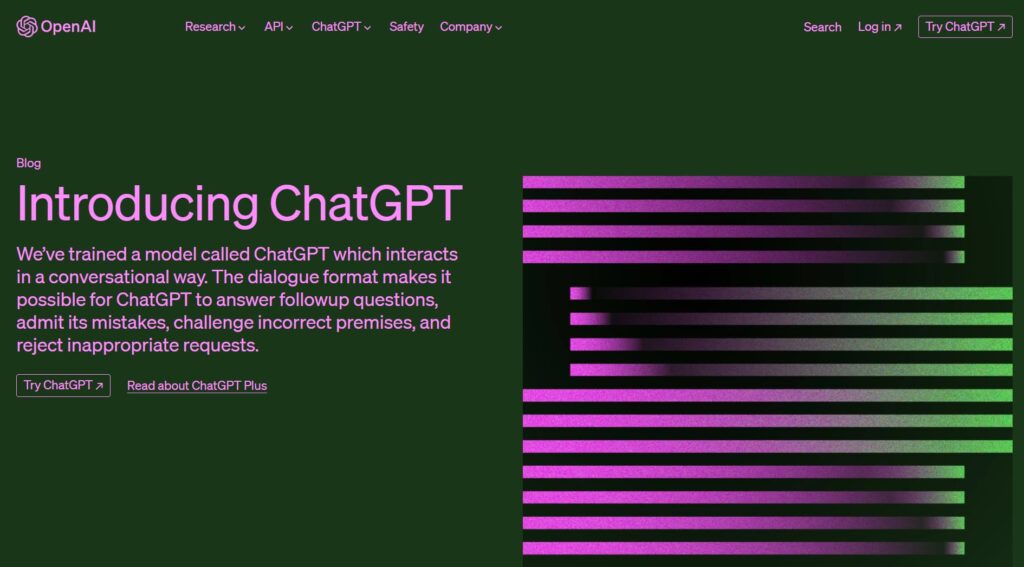
In this article, we’ll show you how affiliate marketers can use ChatGPT to streamline their workflow, increase their productivity, and achieve better results, keeping up with their pace without sacrificing quality.
We’ve handpicked the most effective ways to use ChatGPT for your affiliate marketing strategy.
Content ideation is a critical phase in content marketing where you brainstorm potential topics that align with your audience’s interests and business goals. ChatGPT can be a valuable tool in this step, helping you generate diverse ideas quickly. However, it’s essential to complement these ideas with current market trends and data, since ChatGPT’s training only includes information up to 2021.
Steps to use ChatGPT for content ideation:
Prompt examples:
See what results ChatGPT can generate:
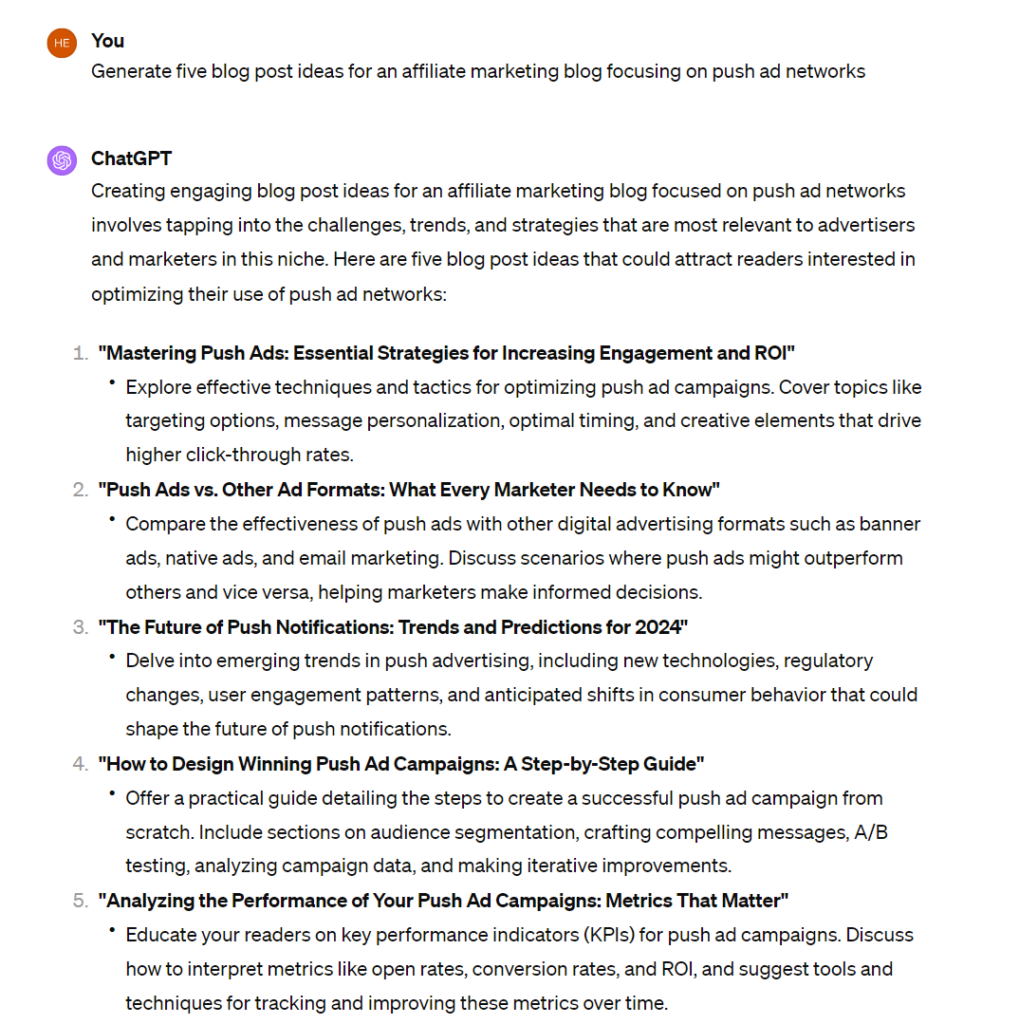
After getting a batch of ideas from ChatGPT, it’s important to refine them. Use tools like Google Trends to see how often these topics are searched for and discussed.
Headlines act as the first impression and can significantly affect click-through rates and engagement. A tool like ChatGPT can help you make catchy, creative, and SEO-friendly headlines.
Steps to use ChatGPT for brainstorming headlines:
Prompt examples:
See what results ChatGPT can generate:
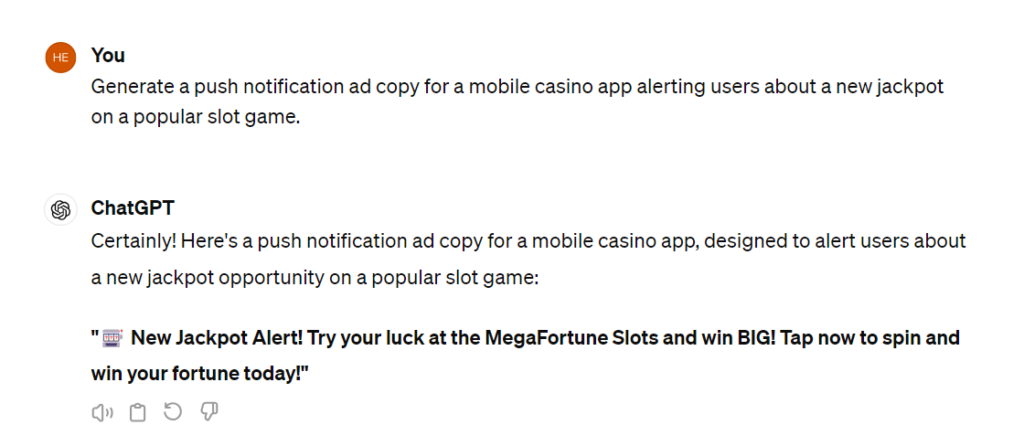
Evaluate each headline based on SEO potential, appeal and relevance. After selecting a headline, adjust for length, ensuring it fits within Google search results without getting cut off.
ChatGPT can significantly streamline this process, helping generate ideas, draft content, and provide inspiration for edits. However, it’s important to remember that while ChatGPT can offer a strong starting point, human insight and customization are key to creating truly relevant content.
Steps to use ChatGPT for writing content:
Example prompts:
To refine results, outline the tone, style, and key points to be included in the content. Affiliate marketers and creators can choose the appropriate ChatGPT tone modifiers in this table:
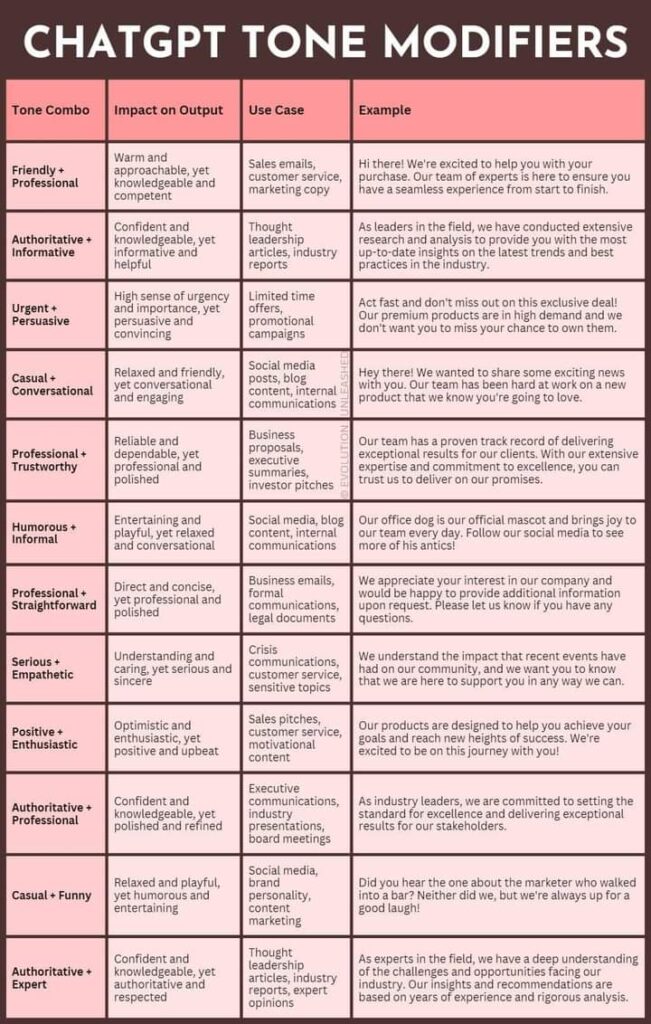
An enhanced method for crafting posts involves using advanced ChatGPT applications, such as the Voice/Style/Tone AI Prompt Snippet Generator. This tool is specifically engineered to analyze the style and tone of your existing content and generate customized prompts tailored to these elements. By utilizing these tailored prompts, you can consistently create content that maintains your unique voice and style.
Search Engine Optimization (SEO) is essential for enhancing visibility and driving traffic to your website. ChatGPT can significantly aid in various SEO tasks.
Follow these methods to effectively leverage ChatGPT in your SEO strategy.
Ask ChatGPT to help integrate keywords into existing content or create new content drafts that are optimized for SEO. By incorporating keywords naturally into content, ChatGPT ensures that your posts are both user-friendly and optimized for search engines.
Prompt example: Revise this blog introduction to include keywords related to CPA offers effectively.
See what results ChatGPT can generate:
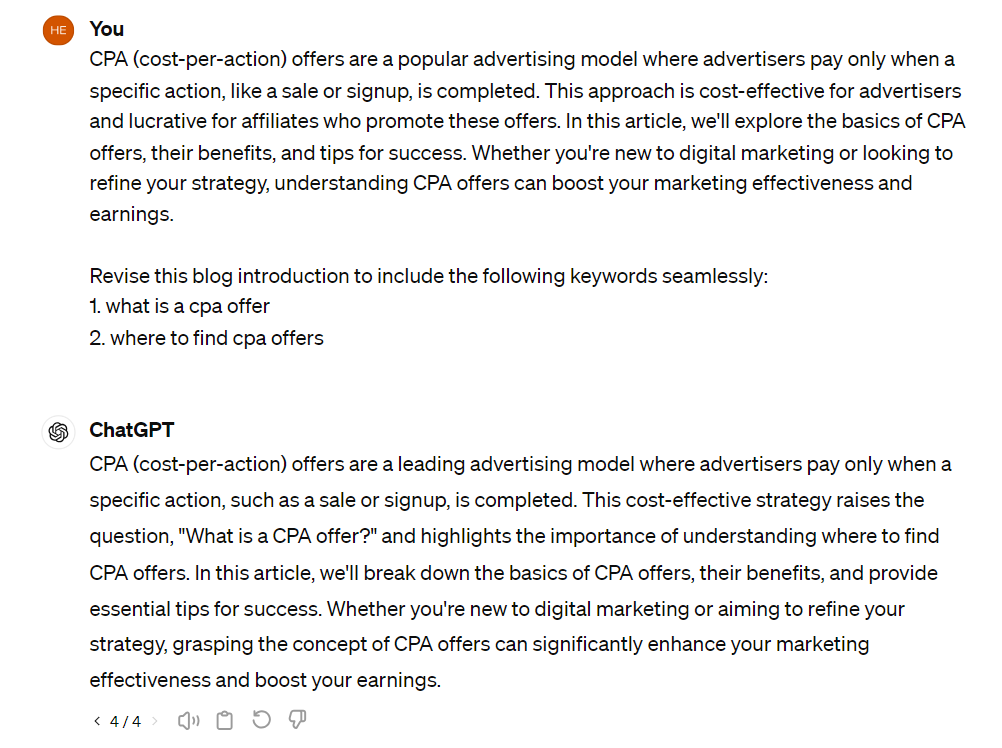
Direct ChatGPT to craft compelling meta descriptions and title tags that incorporate primary keywords, adhere to character limits, and appeal to both search engines and potential readers.
Prompt example: Create a meta description and title tag for an article about top iGaming ads creatives. Include the “igaming advertising ideas” keyword phrase.
See what results ChatGPT can generate:

Effective meta descriptions and title tags increase the CTR from search engine results pages, enhancing your content’s accessibility and engagement.
Engaging and informative product descriptions capture the attention of potential customers and enhance the user experience. ChatGPT can streamline this task by generating detailed, persuasive descriptions that highlight the benefits and features of your products.
Steps to use ChatGPT for generating product descriptions:
Prompt example: Use a prompt like: “Write a compelling product description for [Product Name], highlighting [feature] and [feature] for [target audience]. Ensure the tone is [desired tone].
See what results ChatGPT can generate:
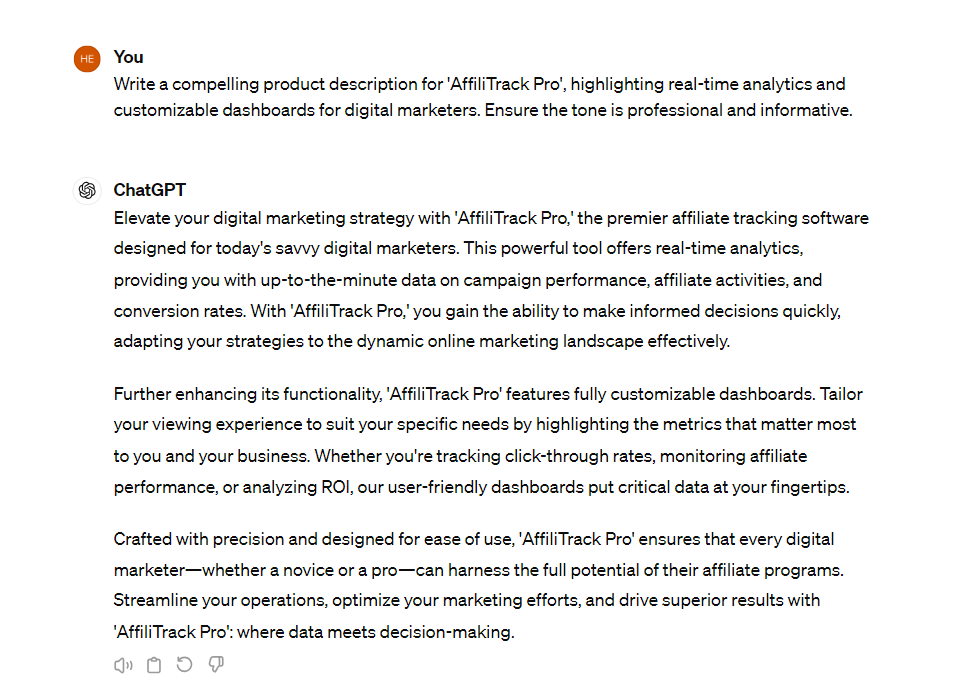
Review the descriptions generated by ChatGPT. Make adjustments to add personality, include any missing features, and ensure that the language perfectly fits your brand voice. This step is critical as it personalizes the AI-generated content, making it unique to your brand.
Email marketing remains one of the most effective channels for engaging customers and promoting products or services. Using ChatGPT, you can create messages that are not only compelling, but also tailored to your audience’s interests.
Steps to use ChatGPT for creating email content:
Prompt example: Create a promotional email for our upcoming webinar on digital marketing trends. Target audience: mid-level marketers. The email should be informative, engaging, and include a CTA to register. The tone should be professional yet approachable.
See what results ChatGPT can generate:
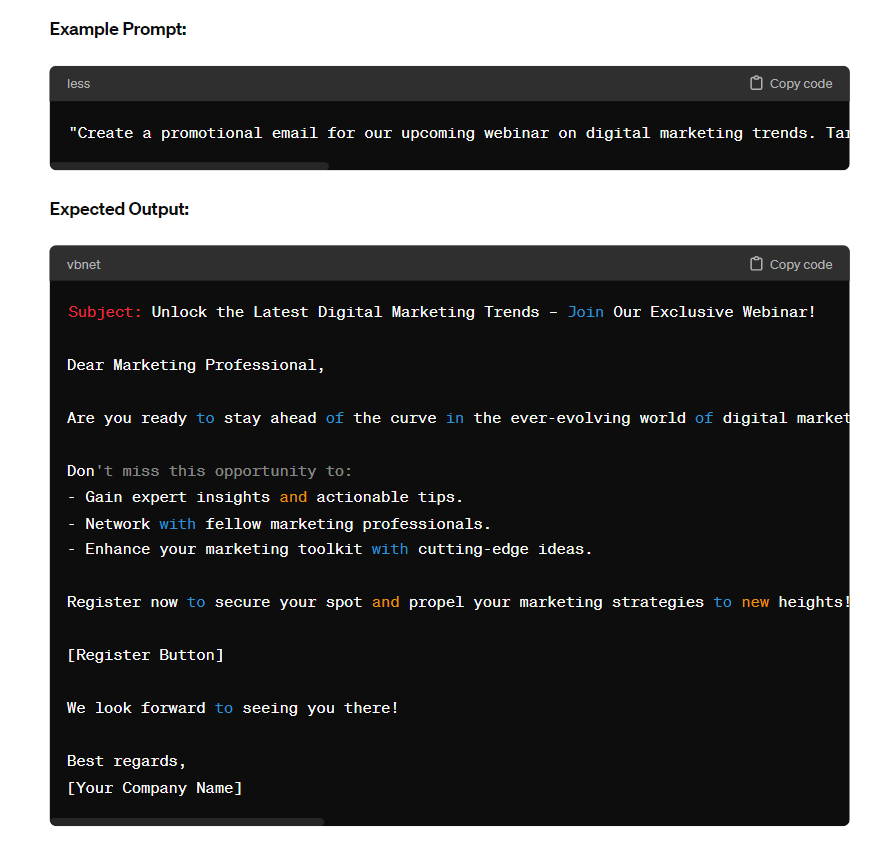
By following these steps, you can harness the power of AI to enhance your email marketing campaigns and achieve better engagement and conversion rates.
Reusing existing content is a practical strategy for affiliate marketers because it maximizes the utility of their past efforts while maintaining message consistency and saving time. When you reuse content, you’re not just recycling what you’ve already created; you’re also amplifying its reach and lifespan.
This practice allows you to keep engaging your audience without constantly having to invent new material. It also boosts SEO, as updated and regularly refreshed content tends to rank higher on search engines. Moreover, repurposing content into different formats can help tap into new audience segments.
Steps to implement ChatGPT for reusing existing content:
Prompt examples:
Creating ad copies is a fundamental aspect of affiliate marketing, requiring a careful balance of creativity, precision, and strategy. Effective ad copies drive action, making them crucial for the success of any affiliate marketing campaign. With the advent of AI technologies like ChatGPT, marketers can simplify the ad copy creation process.
Leverage ChatGPT to generate creative and diverse ad copy variants. Provide ChatGPT with detailed information about the product, audience, and campaign goals to get targeted suggestions.
Prompt examples:
See what results ChatGPT can generate:

Test different versions of ad copies to see which performs best.
While ChatGPT has many benefits, there are several other AI tools and platforms that can also have a profound effect on affiliate marketers’ strategies and earnings.
Here’s a rundown of some other powerful AI tools that can help affiliate marketers thrive:
Jasper AI is a versatile content generation tool that excels in creating high-quality, engaging copy for blogs, emails, and social media posts. By producing creative, SEO-optimized content quickly, Jasper AI can save you hours of writing time, so you can focus on strategy instead. Developers offer more than 500 AI prompts to use Jasper. Affiliates can filter this library by popular use cases, such as Social Media, SEO, Customer Success, Sales, Copywriting and much more.
Canva Magic Write is an AI-powered writing assistant designed to help users quickly generate creative and engaging text for various applications. Magic Write can assist in creating persuasive product descriptions, catchy headlines and effective ad copy that resonate with target audiences. This tool integrates seamlessly into the Canva design platform, allowing marketers to not only write compelling content but also pair it with visually stunning graphics.
Midjourney is an AI tool focused on visual content creation, enabling users to generate high-quality and unique images through text descriptions. This innovative tool can be especially beneficial for affiliate marketers who need custom visuals to enhance their advertising, blog posts or social media content.
In our article on the best AI solutions of 2024, you’ll find more similar tools:
When used wisely, ChatGPT can dramatically enhance the performance of affiliate marketing efforts. It allows marketers to automate routine tasks, generate diverse content ideas quickly, and engage with their audience in a more personalized way. However, the best results are achieved when ChatGPT is viewed as a complement to – not a replacement for – human expertise and creativity. By understanding its limitations and combining its capabilities with strategic insight and continuous learning, marketers can harness the full potential of AI and achieve superior results.
Affiliate marketing can feel like juggling a dozen balls at once – setting up ad campaigns, monitoring performance, analyzing results, optimizing strategies, creating compelling creatives, and conducting A/B testing. For many, especially those new to the field, this barrage of tasks can be overwhelming, leading to burnout without the right tools and techniques. Fortunately, modern technology offers some respite. One such tool that stands out in simplifying and enhancing the affiliate marketing business is ChatGPT.
ChatGPT for affiliate marketing can automate routine tasks, generate creative content, and provide insights that can significantly improve campaign efficiency.

In this article, we’ll show you how affiliate marketers can use ChatGPT to streamline their workflow, increase their productivity, and achieve better results, keeping up with their pace without sacrificing quality.
We’ve handpicked the most effective ways to use ChatGPT for your affiliate marketing strategy.
Content ideation is a critical phase in content marketing where you brainstorm potential topics that align with your audience’s interests and business goals. ChatGPT can be a valuable tool in this step, helping you generate diverse ideas quickly. However, it’s essential to complement these ideas with current market trends and data, since ChatGPT’s training only includes information up to 2021.
Steps to use ChatGPT for content ideation:
Prompt examples:
See what results ChatGPT can generate:

After getting a batch of ideas from ChatGPT, it’s important to refine them. Use tools like Google Trends to see how often these topics are searched for and discussed.
Headlines act as the first impression and can significantly affect click-through rates and engagement. A tool like ChatGPT can help you make catchy, creative, and SEO-friendly headlines.
Steps to use ChatGPT for brainstorming headlines:
Prompt examples:
See what results ChatGPT can generate:

Evaluate each headline based on SEO potential, appeal and relevance. After selecting a headline, adjust for length, ensuring it fits within Google search results without getting cut off.
ChatGPT can significantly streamline this process, helping generate ideas, draft content, and provide inspiration for edits. However, it’s important to remember that while ChatGPT can offer a strong starting point, human insight and customization are key to creating truly relevant content.
Steps to use ChatGPT for writing content:
Example prompts:
To refine results, outline the tone, style, and key points to be included in the content. Affiliate marketers and creators can choose the appropriate ChatGPT tone modifiers in this table:

An enhanced method for crafting posts involves using advanced ChatGPT applications, such as the Voice/Style/Tone AI Prompt Snippet Generator. This tool is specifically engineered to analyze the style and tone of your existing content and generate customized prompts tailored to these elements. By utilizing these tailored prompts, you can consistently create content that maintains your unique voice and style.
Search Engine Optimization (SEO) is essential for enhancing visibility and driving traffic to your website. ChatGPT can significantly aid in various SEO tasks.
Follow these methods to effectively leverage ChatGPT in your SEO strategy.
Ask ChatGPT to help integrate keywords into existing content or create new content drafts that are optimized for SEO. By incorporating keywords naturally into content, ChatGPT ensures that your posts are both user-friendly and optimized for search engines.
Prompt example: Revise this blog introduction to include keywords related to CPA offers effectively.
See what results ChatGPT can generate:

Direct ChatGPT to craft compelling meta descriptions and title tags that incorporate primary keywords, adhere to character limits, and appeal to both search engines and potential readers.
Prompt example: Create a meta description and title tag for an article about top iGaming ads creatives. Include the “igaming advertising ideas” keyword phrase.
See what results ChatGPT can generate:

Effective meta descriptions and title tags increase the CTR from search engine results pages, enhancing your content’s accessibility and engagement.
Engaging and informative product descriptions capture the attention of potential customers and enhance the user experience. ChatGPT can streamline this task by generating detailed, persuasive descriptions that highlight the benefits and features of your products.
Steps to use ChatGPT for generating product descriptions:
Prompt example: Use a prompt like: “Write a compelling product description for [Product Name], highlighting [feature] and [feature] for [target audience]. Ensure the tone is [desired tone].
See what results ChatGPT can generate:

Review the descriptions generated by ChatGPT. Make adjustments to add personality, include any missing features, and ensure that the language perfectly fits your brand voice. This step is critical as it personalizes the AI-generated content, making it unique to your brand.
Email marketing remains one of the most effective channels for engaging customers and promoting products or services. Using ChatGPT, you can create messages that are not only compelling, but also tailored to your audience’s interests.
Steps to use ChatGPT for creating email content:
Prompt example: Create a promotional email for our upcoming webinar on digital marketing trends. Target audience: mid-level marketers. The email should be informative, engaging, and include a CTA to register. The tone should be professional yet approachable.
See what results ChatGPT can generate:

By following these steps, you can harness the power of AI to enhance your email marketing campaigns and achieve better engagement and conversion rates.
Reusing existing content is a practical strategy for affiliate marketers because it maximizes the utility of their past efforts while maintaining message consistency and saving time. When you reuse content, you’re not just recycling what you’ve already created; you’re also amplifying its reach and lifespan.
This practice allows you to keep engaging your audience without constantly having to invent new material. It also boosts SEO, as updated and regularly refreshed content tends to rank higher on search engines. Moreover, repurposing content into different formats can help tap into new audience segments.
Steps to implement ChatGPT for reusing existing content:
Prompt examples:
Creating ad copies is a fundamental aspect of affiliate marketing, requiring a careful balance of creativity, precision, and strategy. Effective ad copies drive action, making them crucial for the success of any affiliate marketing campaign. With the advent of AI technologies like ChatGPT, marketers can simplify the ad copy creation process.
Leverage ChatGPT to generate creative and diverse ad copy variants. Provide ChatGPT with detailed information about the product, audience, and campaign goals to get targeted suggestions.
Prompt examples:
See what results ChatGPT can generate:

Test different versions of ad copies to see which performs best.
While ChatGPT has many benefits, there are several other AI tools and platforms that can also have a profound effect on affiliate marketers’ strategies and earnings.
Here’s a rundown of some other powerful AI tools that can help affiliate marketers thrive:
Jasper AI is a versatile content generation tool that excels in creating high-quality, engaging copy for blogs, emails, and social media posts. By producing creative, SEO-optimized content quickly, Jasper AI can save you hours of writing time, so you can focus on strategy instead. Developers offer more than 500 AI prompts to use Jasper. Affiliates can filter this library by popular use cases, such as Social Media, SEO, Customer Success, Sales, Copywriting and much more.
Canva Magic Write is an AI-powered writing assistant designed to help users quickly generate creative and engaging text for various applications. Magic Write can assist in creating persuasive product descriptions, catchy headlines and effective ad copy that resonate with target audiences. This tool integrates seamlessly into the Canva design platform, allowing marketers to not only write compelling content but also pair it with visually stunning graphics.
Midjourney is an AI tool focused on visual content creation, enabling users to generate high-quality and unique images through text descriptions. This innovative tool can be especially beneficial for affiliate marketers who need custom visuals to enhance their advertising, blog posts or social media content.
In our article on the best AI solutions of 2024, you’ll find more similar tools:
When used wisely, ChatGPT can dramatically enhance the performance of affiliate marketing efforts. It allows marketers to automate routine tasks, generate diverse content ideas quickly, and engage with their audience in a more personalized way. However, the best results are achieved when ChatGPT is viewed as a complement to – not a replacement for – human expertise and creativity. By understanding its limitations and combining its capabilities with strategic insight and continuous learning, marketers can harness the full potential of AI and achieve superior results.

Blog

Blog